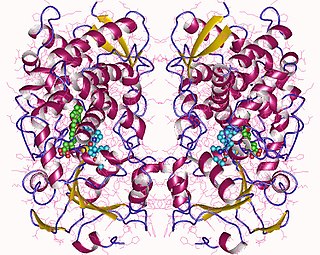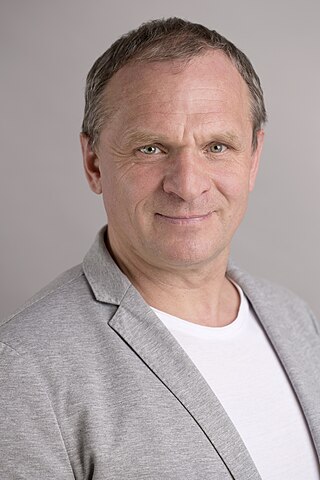Related Research Articles

In vitro studies are performed with microorganisms, cells, or biological molecules outside their normal biological context. Colloquially called "test-tube experiments", these studies in biology and its subdisciplines are traditionally done in labware such as test tubes, flasks, Petri dishes, and microtiter plates. Studies conducted using components of an organism that have been isolated from their usual biological surroundings permit a more detailed or more convenient analysis than can be done with whole organisms; however, results obtained from in vitro experiments may not fully or accurately predict the effects on a whole organism. In contrast to in vitro experiments, in vivo studies are those conducted in living organisms, including humans, known as clinical trials, and whole plants.
In vitro toxicity testing is the scientific analysis of the toxic effects of chemical substances on cultured bacteria or mammalian cells. In vitro testing methods are employed primarily to identify potentially hazardous chemicals and/or to confirm the lack of certain toxic properties in the early stages of the development of potentially useful new substances such as therapeutic drugs, agricultural chemicals and food additives.

A hepatocyte is a cell of the main parenchymal tissue of the liver. Hepatocytes make up 80% of the liver's mass. These cells are involved in:
Genotoxicity is the property of chemical agents that damage the genetic information within a cell causing mutations, which may lead to cancer. While genotoxicity is often confused with mutagenicity, all mutagens are genotoxic, but some genotoxic substances are not mutagenic. The alteration can have direct or indirect effects on the DNA: the induction of mutations, mistimed event activation, and direct DNA damage leading to mutations. The permanent, heritable changes can affect either somatic cells of the organism or germ cells to be passed on to future generations. Cells prevent expression of the genotoxic mutation by either DNA repair or apoptosis; however, the damage may not always be fixed leading to mutagenesis.
In cell biology, microsomes are heterogeneous vesicle-like artifacts re-formed from pieces of the endoplasmic reticulum (ER) when eukaryotic cells are broken-up in the laboratory; microsomes are not present in healthy, living cells.

Cytochrome P450 3A4 is an important enzyme in the body, mainly found in the liver and in the intestine, which in humans is encoded by CYP3A4 gene. It oxidizes small foreign organic molecules (xenobiotics), such as toxins or drugs, so that they can be removed from the body. It is highly homologous to CYP3A5, another important CYP3A enzyme.

Cytochrome P450 2E1 is a member of the cytochrome P450 mixed-function oxidase system, which is involved in the metabolism of xenobiotics in the body. This class of enzymes is divided up into a number of subcategories, including CYP1, CYP2, and CYP3, which as a group are largely responsible for the breakdown of foreign compounds in mammals.

Cytochrome P450 family 2 subfamily C member 9 is an enzyme protein. The enzyme is involved in the metabolism, by oxidation, of both xenobiotics, including drugs, and endogenous compounds, including fatty acids. In humans, the protein is encoded by the CYP2C9 gene. The gene is highly polymorphic, which affects the efficiency of the metabolism by the enzyme.
Integrated discrete Multiple Organ Culture (IdMOC) is an in vitro, cell culture based experimental model for the study of intercellular communication. In conventional in vitro systems, each cell type is studied in isolation ignoring critical interactions between organs or cell types. IdMOC technology is based on the concept that multiple organs signal or communicate via the systemic circulation (i.e., blood).
Cytochrome P450, family 3, subfamily A, also known as CYP3A, is a human gene locus. A homologous locus is found in mice.
The S9 fraction is the product of an organ tissue homogenate used in biological assays. The S9 fraction is most frequently used in assays that measure the metabolism of drugs and other xenobiotics. It is defined by the U.S. National Library of Medicine's "IUPAC Glossary of Terms Used in Toxicology" as the "Supernatant fraction obtained from an organ homogenate by centrifuging at 9000 g for 20 minutes in a suitable medium; this fraction contains cytosol and microsomes." The microsomes component of the S9 fraction contain cytochrome P450 isoforms and other enzyme activities. The cytosolic portion contains the major part of the activities of transferases. The S9 fraction is easier to prepare than purified microsomes.

Sean Ekins is a British pharmacologist and expert in the fields of ADME/Tox, computational toxicology and cheminformatics at Collaborations in Chemistry, a division of corporate communications firm Collaborations in Communications. He is also the editor of four books and a book series for John Wiley & Sons.
An organ-on-a-chip (OOC) is a multi-channel 3-D microfluidic cell culture, integrated circuit (chip) that simulates the activities, mechanics and physiological response of an entire organ or an organ system. It constitutes the subject matter of significant biomedical engineering research, more precisely in bio-MEMS. The convergence of labs-on-chips (LOCs) and cell biology has permitted the study of human physiology in an organ-specific context. By acting as a more sophisticated in vitro approximation of complex tissues than standard cell culture, they provide the potential as an alternative to animal models for drug development and toxin testing.

Menthofuran is an organic compound found in a variety of essential oils including that of pennyroyal. It is highly toxic and believed to be the primary toxin in pennyroyal responsible for its potentially fatal effects. After ingestion of menthofuran, it is metabolically activated to chemically reactive intermediates that are hepatotoxic.

Harry V. Gelboin (1929–2010) was an American cancer research scientist, particularly in chemical carcinogenesis. From 1966 to 1999, he was Chief of the Laboratory of Molecular Carcinogenics at the National Cancer Institute (NCI), part of the National Institutes of Health (NIH). His research focused on the activation and detoxification of drugs and carcinogens. He is best known for his studies of the genetic mechanisms by which normal cells transform into malignancy, which constituted a major advance in cancer research.
A 3D cell culture is an artificially created environment in which biological cells are permitted to grow or interact with their surroundings in all three dimensions. Unlike 2D environments, a 3D cell culture allows cells in vitro to grow in all directions, similar to how they would in vivo. These three-dimensional cultures are usually grown in bioreactors, small capsules in which the cells can grow into spheroids, or 3D cell colonies. Approximately 300 spheroids are usually cultured per bioreactor.
MC2 Biotek is a biotechnology company established in 2006, with offices in Denmark and external labs in the United Kingdom. MC2 is a holding company, comprising three smaller Biotechnology companies with their own biotechnology solutions, they are: DrugMode (DK), Zadec (DK), and Drug Delivery Solutions (UK). DrugMode specializes in 3D cell culture, and is based out of the University of Southern Denmark at Odense. Zadec focuses on Diabetes and nutrition, and has developed an oral anti-diabetes drug, RX-1, which is currently in clinical trials. Drug Delivery Solutions works in the field of dermatology and ophthalmology, developing topical drugs such as a cream to treat psoriasis.

Bisphenol F is an organic compound with the chemical formula (HOC
6H
4)
2CH
2. It is structurally related to bisphenol A (BPA), a popular precursor for forming plastics, as both belong to the category of molecules known as bisphenols, which feature two phenol groups connected via a linking group. In BPF, the two aromatic rings are linked by a methylene connecting group. In response to concern about the health effects of BPA, BPF is increasingly used as a substitute for BPA.

Uwe Marx is a German physician and biotechnologist, and one of the world’s leading researchers in the fields of organ-on-a-chip technology and antibody production.

HepaRG cell line is a human hepatic in vitro line used in liver biology research and for assessing liver pathology, hepatotoxicity, and drug-induced injury. The HepaRG model is considered a surrogate for Primary Human Hepatocytes, which are the most pertinent model to reproduce the human liver functioning as they express 99% of the same genes.
References
- 1 2 3 4 "Meet Our CEO". In Vitro ADMET Laboratories, LLC. Archived from the original on 2015-11-25. Retrieved 2015-10-08.
- ↑ "In Vitro ADMET Laboratories, LLC | Meet Our CEO". 2015-11-25. Archived from the original on 2015-11-25. Retrieved 2022-09-21.
- ↑ "In Vitro ADMET Laboratories, LLC | Meet Our CEO". 2015-11-25. Archived from the original on 2015-11-25. Retrieved 2022-09-21.
- ↑ "In Vitro ADMET Laboratories, LLC | Meet Our CEO". 2015-11-25. Archived from the original on 2015-11-25. Retrieved 2022-09-21.
- ↑ "In Vitro ADMET Laboratories, LLC | Meet Our CEO". 2015-11-25. Archived from the original on 2015-11-25. Retrieved 2022-09-21.
- ↑ "In Vitro ADMET Laboratories, LLC | Meet Our CEO". 2015-11-25. Archived from the original on 2015-11-25. Retrieved 2022-09-21.
- ↑ "About IVAL". In Vitro ADMET Laboratories, LLC. Archived from the original on 2015-11-25. Retrieved 2015-10-08.
- 1 2 "Hepatocytes, Media, Contract Research | In Vitro ADMET Laboratories". invitroadmet.com. Retrieved 2015-10-08.
- ↑ Li, Albert P. (2007-05-20). "Human hepatocytes: isolation, cryopreservation and applications in drug development". Chemico-Biological Interactions. 168 (1): 16–29. doi:10.1016/j.cbi.2007.01.001. ISSN 0009-2797. PMID 17270162.
- 1 2 United States Patent: 7186548 – Cell culture tool and method , retrieved 2015-09-22
- ↑ "Editorial Board ::: Current Drug Metabolism". benthamscience.com. Retrieved 2015-09-23.
- ↑ "Editorial Board ::: Drug Metabolism Letters". benthamscience.com. Retrieved 2015-09-23.
- ↑ "Chemico-Biological Interactions Editorial Board". Elsevier. Retrieved 2015-09-23.
- ↑ "Editorial Board: The Journal of Toxicological Sciences". www.jtoxsci.org. Retrieved 2015-09-23.
- ↑ "Cell Biology and Toxicology – incl. option to publish open access (Editorial Board)". springer.com. Retrieved 2015-09-23.
- ↑ United States Patent: 5270192 – Biological artificial liver , retrieved 2015-09-22
- ↑ United States Patent: 6858146 – Artificial liver apparatus and method , retrieved 2015-09-22
- ↑ "Cell Culture Tool and Method". State Intellectual Property Office of the P.R.C. Archived from the original on 2018-09-30. Retrieved 2015-09-22.
- ↑ "Japanese Patent No. 4609799". Japan Platform for Patent Information. Archived from the original on 2018-09-30. Retrieved 2015-09-22.
- ↑ United States Patent: 9078430 – Cell preparation method , retrieved 2015-09-22